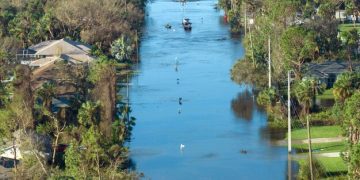Coastal Tourism Economic Impact: 2025 Trends & Forecasts

The economic impact of coastal tourism, a vital segment of the global travel industry, is projected to strengthen significantly by 2025, driven by evolving consumer preferences, sustainable practices, and technological advancements, despite facing challenges from climate change and geopolitical shifts, necessitating adaptive strategies for continued growth and resilience.
As the waves of change continually reshape industries, few sectors feel the ebb and flow quite as acutely as coastal tourism. More than just leisure destinations, coastal areas are dynamic economic engines, and understanding The Economic Impact of Coastal Tourism: Trends and Forecasts for 2025 is crucial for stakeholders worldwide. This article delves into how these vibrant regions contribute to global economies, exploring the latest trends and peering into the crystal ball of 2025 to anticipate what lies ahead for this thriving sector.
The enduring allure of coastal destinations
Coastal regions have long captivated humanity with their unique blend of natural beauty and recreational opportunities. From serene beaches to bustling port cities, these areas offer a diverse array of experiences that attract millions of visitors annually. This inherent appeal translates directly into substantial economic activity, positioning coastal tourism as a cornerstone for many national and regional economies.
The magnetism of the coastline is multifaceted. It stems from the promise of relaxation, adventure, and cultural immersion. Sun-seekers flock to sandy shores for rejuvenation, while water sports enthusiasts are drawn to the thrill of surfing, diving, or sailing. Beyond recreation, the unique ecosystems and cultural heritage of coastal communities offer rich educational experiences, fostering a deeper connection between visitors and the environment. This broad appeal ensures a continuous demand, making coastal tourism a resilient industry, even in the face of global uncertainties.
Driving forces behind coastal tourism’s economic significance
Several key factors underpin the significant economic contributions of coastal tourism. One primary driver is the sheer volume of visitors. Mass tourism to coastal areas generates substantial revenue through accommodation, food and beverage services, retail, and transportation. Beyond these direct expenditures, the sector creates a ripple effect throughout local economies, stimulating growth in ancillary services and industries.
- Direct spending: Tourist expenditure on hotels, restaurants, shops, and attractions.
- Employment generation: Creation of jobs across hospitality, retail, and service sectors.
- Infrastructure development: Investment in roads, airports, and utilities to support tourism.
- Local business support: Increased demand for local produce, crafts, and services.
Moreover, the distinct characteristics of coastal environments often necessitate specialized infrastructure and services, further diversifying economic opportunities. Marinas require maintenance, diving schools need equipment, and coastal conservation efforts create jobs in environmental management. This intricate web of economic activities underscores why coastal tourism is not merely a leisure activity but a powerful economic engine that deserves careful attention and strategic planning.
As we advance towards 2025, the economic contributions of coastal tourism are poised for further expansion, driven by renewed global travel, shifting consumer preferences towards unique experiences, and continued investment in sustainable tourism practices. The ability of these regions to adapt to environmental changes and foster responsible development will be paramount in sustaining and enhancing their economic output.
Key economic indicators and their trends
To fully grasp the economic impact of coastal tourism, it is essential to examine the key indicators that measure its health and growth. These metrics provide a quantitative understanding of the sector’s contribution to GDP, employment, and overall economic development. Analyzing their trends offers insights into the trajectory of coastal tourism as we approach 2025.
One of the foremost indicators is the contribution to Gross Domestic Product (GDP). Coastal tourism directly and indirectly accounts for a substantial percentage of GDP in many coastal nations, often surpassing other traditional industries. This includes direct spending by tourists, revenue generated by tourism-related businesses, and the multiplier effect as this money circulates through the economy. The trend over the past decade has shown a consistent upward trajectory, resilient even through periods of global economic fluctuation, underscoring its robustness.
Employment and job creation in coastal communities
Beyond GDP, employment generation is a critical economic indicator. Coastal tourism is undeniably a significant employer, offering a wide range of jobs from hospitality and food services to retail, transportation, and specialized recreational activities. The sector often provides opportunities in regions where other industries may be declining, serving as a vital source of livelihood for local populations.
- Hospitality roles: Hotel staff, resort managers, tour guides.
- Service industry jobs: Restaurant workers, retail associates, transportation providers.
- Specialized skills: Dive instructors, surf coaches, marine biologists for eco-tourism.
- Indirect employment: Construction workers, suppliers, local artisans.
The trend shows a steady increase in employment within the coastal tourism sector globally, with a particular surge in demand for skilled workers in niche tourism segments like eco-tourism and wellness tourism. This growth is anticipated to continue, with forecasts for 2025 indicating a greater emphasis on professional development and career opportunities within the industry.
Furthermore, infrastructure development and foreign direct investment (FDI) are strong indicators of the sector’s economic health. Significant investments in airports, roads, ports, and digital infrastructure facilitate easier access for tourists and enhance the overall visitor experience. FDI into coastal tourism projects, such as luxury resorts, integrated developments, and sustainable tourism initiatives, highlights international confidence in the sector’s long-term viability. These trends collectively paint a picture of a dynamic and expanding industry, poised for continued economic significance in the coming years.
Emerging trends shaping coastal tourism
The landscape of coastal tourism is continuously evolving, shaped by changing consumer preferences, technological advancements, and a growing global awareness of sustainability issues. Understanding these emerging trends is crucial for stakeholders looking to innovate and remain competitive as we cast our gaze towards 2025.
One of the most significant shifts is the growing demand for sustainable and eco-friendly tourism. Travelers are becoming increasingly conscious of their environmental footprint and are actively seeking destinations and operators that prioritize conservation, responsible resource management, and local community engagement. This trend is not merely a niche but a mainstream expectation, driving a transformation in how coastal tourism businesses operate and market themselves. From eco-resorts powered by renewable energy to tours focused on marine conservation, sustainability is becoming a key differentiator.
The rise of experiential and wellness tourism
Another prominent trend is the pivot towards experiential and wellness-focused travel. Travelers are moving beyond passive sightseeing, seeking immersive experiences that allow them to connect deeply with the local culture, environment, and themselves. This includes activities such as local cooking classes, traditional craft workshops, community-based tourism initiatives, and adventure sports tailored to coastal settings.
- Authentic cultural immersion: Engaging with local traditions and communities.
- Adventure and active holidays: Surfing, kayaking, hiking coastal trails.
- Wellness retreats: Yoga, meditation, and healthy living programs by the sea.
- Gastronomic tourism: Exploring local seafood and culinary traditions.
Wellness tourism, in particular, is flourishing in coastal areas, leveraging the natural tranquility and therapeutic properties of the ocean. Resorts are increasingly offering comprehensive wellness programs that combine fitness, nutrition, mindfulness, and spa treatments, appealing to a segment of travelers focused on health and rejuvenation.
Furthermore, technology continues to redefine the coastal tourism experience. From virtual reality previews of destinations to AI-powered personalized travel planning and seamless mobile booking platforms, digital innovation is enhancing convenience and accessibility for travelers. Social media also plays a pivotal role, with visually stunning coastal destinations often going viral, attracting a new generation of travelers. These technological advancements, combined with the increasing emphasis on personalization and unique experiences, are setting the stage for a more dynamic and tailored coastal tourism market in 2025.
Challenges and opportunities for coastal economies
While the economic outlook for coastal tourism remains largely positive, the sector is not without its significant challenges. These hurdles, ranging from environmental threats to geopolitical volatility, demand proactive strategies and innovative solutions to ensure sustained growth and resilience. However, alongside these challenges come significant opportunities for economic diversification and sustainable development.
Climate change poses perhaps the most pressing long-term challenge. Rising sea levels, increased frequency and intensity of extreme weather events, and ocean acidification threaten coastal infrastructure, natural attractions, and marine ecosystems directly. Erosion can destroy beaches, storm surges can devastate hotels, and coral bleaching impacts vital dive tourism. Adapting to these changes requires substantial investment in protective infrastructure, ecosystem restoration, and the development of climate-resilient tourism models. The economic impact of neglected climate action could be severe, affecting tourism appeal and property values.
Addressing overtourism and promoting sustainable practices
Another critical challenge is overtourism. Popular coastal destinations often struggle with the sheer volume of visitors, leading to environmental degradation, strains on local resources, cultural dilution, and diminished visitor experiences. Addressing overtourism requires careful planning, including visitor dispersal strategies, capacity management, and investment in sustainable transport and waste management systems.
- Environmental degradation: Pollution and damage to natural habitats.
- Infrastructure strain: Overburdened public services and transport.
- Cultural impact: Loss of local identity and disruption to daily life.
- Economic leakage: Benefits not reaching local communities effectively.
Despite these challenges, opportunities abound. The increasing demand for sustainable tourism presents a chance to rebrand and invest in eco-friendly practices that appeal to a growing market segment. Diversification away from sun-and-sand tourism to include cultural, historical, and adventure tourism can reduce dependence on specific attractions and spread economic benefits more broadly. Furthermore, investing in local community involvement and entrepreneurship can ensure that the economic benefits of tourism are shared more equitably, fostering local ownership and engagement. Finally, leveraging technology for smarter resource management, personalized visitor experiences, and effective crisis communication offers a powerful pathway to future resilience and growth, turning challenges into catalysts for innovation and sustainable economic development.
Government policies and investment strategies in coastal regions
The role of supportive government policies and strategic investment is paramount in shaping the future and maximizing the economic impact of coastal tourism. Effective governance can mitigate challenges, foster sustainable growth, and ensure that the benefits of tourism are equitably distributed across coastal communities. As we look towards 2025, a clear framework of policies and investments will be critical.
Governments are increasingly recognizing the need for integrated coastal zone management. This involves a comprehensive approach that balances economic development with environmental protection and social equity. Policies often include zoning regulations to control development, protected area designations to conserve critical habitats, and incentives for developers to adopt green building practices. The aim is to create a resilient tourism infrastructure that can withstand environmental pressures and maintain its natural appeal.
Investment in sustainable infrastructure and resilient communities
Strategic investment is another key pillar. This extends beyond traditional tourism infrastructure (like airports and hotels) to include funding for climate adaptation measures, such as sea defenses and wetland restoration. Investments in public transportation, renewable energy sources, and waste management facilities are also crucial for sustainability and enhancing the visitor experience.
- Coastal protection: Funding for sea walls, dune restoration, and mangrove planting.
- Sustainable transport: Development of public transit, bike paths, and electric vehicle charging stations.
- Renewable energy projects: Support for solar and wind power in tourism operations.
- Waste management: Investment in recycling facilities and circular economy initiatives.
Beyond physical infrastructure, governments are also investing in human capital. This includes vocational training programs for tourism workers, digital literacy initiatives for local businesses, and support for artisans and cultural practitioners to develop unique tourism products. Such investments directly empower local communities and ensure that the wealth generated by tourism stays within the region, fostering long-term economic stability and reducing reliance on external resources.
Moreover, policies promoting public-private partnerships are vital. Collaboration between government bodies, private sector tourism operators, and local communities can lead to more innovative and effective solutions for sustainable development, marketing, and crisis management. Tax incentives for sustainable tourism businesses, grants for eco-tourism initiatives, and frameworks for community-based tourism models are examples of how governments are encouraging responsible investment. By combining robust policy frameworks with targeted investments and collaborative efforts, coastal regions can solidify their economic future in tourism, navigate emerging challenges, and capitalize on new opportunities as 2025 unfolds.
Forecasts for 2025: economic outlook
Peering into the future, the economic forecasts for coastal tourism in 2025 suggest a trajectory of continued growth, albeit with a stronger emphasis on sustainability, resilience, and technological integration. While global economic conditions and geopolitical factors will undoubtedly play a role, the underlying trends indicate a robust recovery and expansion for the sector.
One key forecast is the continued increase in international tourist arrivals to coastal regions. With eased travel restrictions and pent-up demand, destinations are expected to see a significant uplift in visitor numbers, surpassing pre-pandemic levels in many areas. This influx will translate into higher direct expenditures, boosting GDP contributions and employment figures. Emerging markets, particularly in Asia and Latin America, are also anticipated to contribute substantially to this growth, as their middle classes expand and travel becomes more accessible.
Shifting investment priorities and market segmentation
Investment patterns are also expected to evolve. 2025 will likely see greater capital flowing into sustainable tourism infrastructure, including eco-friendly accommodations, conservation projects, and smart technology solutions for destination management. Private equity firms and impact investors are increasingly targeting ventures that align with environmental, social, and governance (ESG) criteria, making sustainable coastal tourism projects particularly attractive.
- Eco-friendly accommodations: Funding for green hotels and resorts.
- Marine conservation: Investment in coral reef restoration and marine park development.
- Smart city technologies: Digital solutions for managing visitor flows and resource consumption.
- Local community enterprises: Support for small, locally-owned tourism businesses.
Market segmentation will become even more refined. The demand for niche tourism experiences, such as medical tourism in coastal towns, specialized adventure sports, and heritage travel that highlights coastal cultures, is projected to grow significantly. This specialization will allow destinations to command higher value, diversify their tourism offerings, and reduce dependence on mass-market segments. The shift towards “slow travel” and longer stays will also gain traction, encouraging deeper engagement with destinations and potentially leading to higher per-traveler spending.
Finally, technology will be a pervasive force, not just in booking and marketing, but in shaping the visitor experience itself. Augmented reality tours, personalized digital guides, and blockchain for secure transactions are some innovations poised for wider adoption. Data analytics will become indispensable for understanding visitor behavior, optimizing resource allocation, and predicting trends. Overall, the 2025 economic outlook for coastal tourism is one of strategic evolution: a sector that is not just growing in volume but also in its commitment to responsible development, leveraging innovation to create more resilient, valuable, and enjoyable experiences for all.
The US coastal tourism landscape: particularities and outlook for 2025
The United States, with its vast and diverse coastline stretching across thousands of miles, presents a unique and dynamic landscape for coastal tourism. From the sunny beaches of California and Florida to the rugged shores of the Pacific Northwest and the historic towns of the Northeast, US coastal regions offer an unparalleled array of experiences. Understanding the particularities of this landscape and its outlook for 2025 requires a closer look at domestic travel patterns, infrastructure, and regional economic dynamics.
A distinctive feature of US coastal tourism is its strong reliance on domestic travel. While international visitors contribute significantly, a large portion of coastal tourism revenue comes from Americans exploring their own shores. This robust domestic market provides a degree of resilience against global travel disruptions. The sheer number of accessible coastal destinations, combined with a culture of road trips and regional vacations, ensures consistent demand. States like Florida and California consistently rank among the top tourism earners due to their well-established coastal attractions, drawing millions annually.
Regional variations and infrastructure strengths
The US coastal landscape is not monolithic; it encompasses diverse regional particularities. The Pacific Coast, for instance, emphasizes natural beauty, outdoor adventure, and eco-tourism, with destinations like Oregon and Washington catering to a different kind of traveler than the entertainment-focused beaches of South Florida. The Gulf Coast combines beach relaxation with oil industry influence, while the Northeast coastal areas blend historic charm with fishing traditions.
- Southeast (Florida, Carolinas): Beach resorts, theme parks, family tourism.
- Northeast (New England, Mid-Atlantic): Historic sites, charming towns, seafood, autumn foliage.
- Pacific Northwest (Oregon, Washington): Rugged coastlines, nature tourism, outdoor activities.
- California: Diverse beaches, surfing, celebrity hotspots, wine regions.
The infrastructure supporting US coastal tourism is generally well-developed, with extensive transportation networks, a wide range of accommodation options, and advanced digital connectivity. Major airports near coastal hubs facilitate easy access, and a strong hospitality sector is adept at catering to diverse traveler needs. For 2025, the outlook for US coastal tourism is positive, benefiting from continued domestic demand and an anticipated increase in international arrivals. Investment in sustainable practices, coastal resiliency projects, and smart tourism technologies will likely be a focus, as regions seek to mitigate climate change impacts while enhancing visitor experiences. The ongoing trend towards experiential and wellness travel also aligns well with the diverse offerings of US coastal regions, positioning them for sustained economic growth and innovation in the years to come.
| Key Point | Brief Description |
|---|---|
| 💰 Economic Engine | Coastal tourism significantly boosts GDP, creates jobs, and drives infrastructure development in many regions. |
| 🌱 Sustainability Focus | Growing demand for eco-friendly practices and responsible tourism is reshaping the industry. |
| 🔬 Tech Integration | Technology is enhancing personalized experiences and operational efficiency in coastal travel. |
| 🚢 2025 Outlook | Forecasts predict growth driven by increased international arrivals and diversified, high-value experiential tourism. |
Frequently Asked Questions About Coastal Tourism Economics
▼
Coastal tourism primarily contributes to a region’s economy through direct tourist spending on accommodation, food, transportation, and activities, alongside significant job creation across various sectors like hospitality, retail, and recreational services. It also drives infrastructure development and supports local businesses, creating a substantial multiplier effect. Beyond direct revenue, it promotes regional brand visibility and attractiveness for investment.
▼
Climate change poses a significant threat to coastal tourism economies through rising sea levels, increased erosion, and more frequent extreme weather events. These impacts can damage vital infrastructure, degrade natural attractions like beaches and coral reefs, and disrupt travel. Adapting requires substantial investment in resilient infrastructure and sustainable management practices to protect both assets and visitor appeal.
▼
By 2025, coastal tourism will be shaped by increased demand for sustainable and eco-friendly travel, a rise in experiential and wellness tourism, and greater integration of technology for personalized and efficient travel experiences. Travelers will prioritize authentic local interactions and environmentally conscious operators. This shift will prompt destinations and businesses to innovate their offerings and operational practices.
▼
Sustainable economic growth in coastal tourism can be achieved through integrated coastal zone management, strategic investments in green infrastructure, and policies promoting community involvement. Diversifying tourism products beyond traditional beach offerings, managing visitor numbers to prevent overtourism, and fostering public-private partnerships are also crucial for long-term resilience and equitable benefit sharing.
▼
The economic outlook for US coastal tourism in 2025 is positive, fueled by strong domestic demand and anticipated growth in international arrivals. The sector will likely see continued investment in resilient infrastructure and technology. Regional diversity will support varied tourism segments, from adventure to historical, while a national focus on sustainability will drive responsible development and innovation, enhancing economic value.
Conclusion
As we navigate the complexities and opportunities of the coming years, The Economic Impact of Coastal Tourism: Trends and Forecasts for 2025 stands out as a story of resilience, adaptation, and sustained growth. Coastal regions, with their inherent allure and diverse offerings, remain formidable economic powerhouses, contributing significantly to global GDP and employment. While challenges like climate change and the imperative for sustainability demand strategic responses, the industry’s ability to innovate through technology and cater to evolving consumer preferences positions it for a vibrant future. The shift towards experiential, wellness, and eco-friendly tourism, combined with targeted government policies and smart investments, underscores a trajectory not just of expansion but of deeper, more responsible engagement with these invaluable natural assets. Ultimately, the economic health of coastal tourism in 2025 will be a testament to a collective commitment to balance prosperity with preservation, ensuring that the waves of opportunity continue to benefit both visitors and local communities alike.





